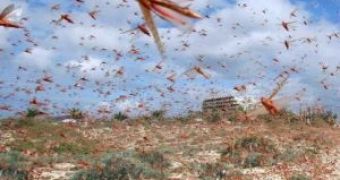1.These insects are famous for their catastrophic invasions, mentioned even in the Bible as the eighth plague. Locusts are divided in about 10,000 species grouped in 10 families. All plague locusts belong to the family Acrididae.
The biblical locust was the Desert Locust (Schistocerca gregaria), which has been threatening agricultural production in Africa (Sahara and the arid area south of Sahara called Sahel), the Middle East and Asia up to India for centuries. For starting its invasions this species needs a body temperature (depending on that of the environment) of 22-40' C. They are 7-8 cm (3 in) long; males weigh 2.2 grams while the females 3.5 grams. The females lay 100 eggs, and the larvae, wingless miniatures of the parents, get to the adult state in 15-20 days.
In a little cloud of invading locusts, covering 100 square kilometers (40 square miles), there are about 70,000 tons of insects, thus several tens of billions of locusts.
Migratory locust (Locusta migratoria) is highly mobile, and usually flies with the wind at a speed of 15-20 km (9-12 mi)/h. Swarms can travel about 5-130 km (3-82 mi) daily. It is found in Africa, Asia, Austalia, Madagascar, eastern Europe and in the past caused severe damages including in Europe. The red locust (Nomadacris septemfasciata) causes severe invasions in southern and eastern Africa. Many countries in the northern Africa, Sahel and Middle East, like Yemen, Chad, Nigeria, and Mali, are extremely vulnerable to locust invasions.
2.Locusts can jump 70 cm (2.3 ft).This is like humans jumping 18 m (60 ft)!
3.Locusts and grasshopers are closely related and have similar look and habits, that's why the question is: how can you differentiate a locust from a grasshoper?
a)locusts have short antennae, grasshopers have very long ones.
b)locusts "sing" by rubbing their rear feet from elytra (the outer tough pair of wings). Grasshopers "sing" by rubbing the elytra between them.
c)locusts have short ovipositor (egg depositing organ) and ootheca (egg capsule); grashopers have long sword-like ovipositors.
4.The first insect ever drawn by humans is a locust. This drawing was found in a bison (wisent) bone, 10,000 years old, encountered in a French cave.

 14 DAY TRIAL //
14 DAY TRIAL //